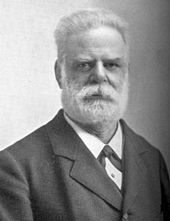Paul Wilhelm Magnus
Paul Wilhelm Magnus (born February 29, 1844 in Berlin ; † March 13, 1914 there ) was a German botanist ( mycologist and lichenologist ) who dealt in particular with phytopathology .
Life
Paul Magnus' father was the secret councilor , banker and silk manufacturer Meyer Magnus (1805-1883), city councilor, member of the college of merchants and, since 1866, chairman of the board of the Jewish community in Berlin . His mother Johanna came from the Viennese merchant and industrialist family Pollack. His sister Anna was married to the banker Eugen Landau , his brother Ernst Magnus was director of the National Bank for Germany from 1891 to 1903 . His nephew Werner Magnus (1876–1942) was a professor of botany in Berlin.
Magnus attended Friedrichswerder High School and began studying medicine at the University of Berlin in 1864 , and in 1865 he changed the subject to natural sciences . In the summer semester of 1866 he studied at the Albert Ludwig University of Freiburg , where Anton de Bary introduced him to mycology . Magnus continued his studies in Berlin and obtained his doctorate in 1870 under Alexander Braun with the thesis Contribution to the knowledge of the genus Najas . He then took part as a botanist in expeditions by the Prussian state to the Baltic Sea in 1871, the North Sea in 1872 and the slime estuary in 1874. At the end of 1871 he joined the Society of Friends . In 1875 he became a private lecturer at the University of Berlin, in 1880 he became an associate professor for botany. In 1897 Magnus visited Canada at the invitation of the British Association for the Advancement of Science and then toured the United States .
Paul Magnus remained single. His grave is in the Jewish cemetery Schönhauser Allee .
Act
Magnus processed the groupage of seaweed from the North and Baltic Sea expeditions and was able to explain the growth of the apex and the branching. Magnus described the algae fungus family Chytridiaceae , the forms of which were previously thought to be organs of seaweed . In 1893 he was involved in the establishment of the Müggelsee biological and fishing station (today the measuring station of the Leibniz Institute for Freshwater Ecology and Inland Fisheries ). Magnus' research devoted himself mainly of mycology , particularly the families of the parasitic Ustilaginaceae ( smut fungus relatives ) and Uredinaceae ( rusts ), the polluters of various plant diseases. Because of his relationships with numerous florists and travelers, he received material from all over the world - including Joseph Friedrich Nicolaus Bornmüller from Syria and Turkey, Georg Schweinfurth from Eritrea and Rudolf Marloth from South Africa . Magnus clarified the biology of many forms, apparently separated by host and generation changes, and described several genera and species anew. He was involved in the processing of the guidelines for the investigation of the flora and fauna ( State Agency for the Preservation of Natural Monuments in Prussia , 1912).
Fonts (selection)
- Contributions to the knowledge of the genus Najas , 1870 online
- On the morphology of the Sphacelarieen, along with remarks about the deflection of the vegetation point of the main axes by the daughter's shoot being created close to the apex , 1873
- The botanical results of the North Sea voyage from July 21 to September 9, 1872 , 1874
- The New Disease of the Vine, the Downy Mildew or Mildew of the Americans , 1883
- Mushrooms of the Canton of Graubuenden , 1890
- The peronospore of the province of Brandenburg , 1893
- Contributions to the fungal flora of Franconia , 1895, 1897, 1899, 1906
- G. Sennholz , 1895
- Joseph Schroeter , 1895
- On some species of the genus Urophlyctis in Annals of Botany 11:41 pp. 87-96, 1897
- The mushrooms (Fungi) of Tyrol, Vorarlberg and Liechtenstein. Volume 3 of the flora of Tyrol, Vorarlberg and Liechtenstein. Edited by Karl Wilhelm von Dalla Torre and Ludwig von Sarnthein , 1905 doi: 10.5962 / bhl.title.3876
Awards (selection)
- Elected to the Leopoldina in 1876
- 1895 Member of the Regensburg Botanical Society (oldest existing botanical society in the world)
- 1911 Privy Councilor
- 1914 honorary member of the Swiss Botanical Society
literature
- Martin Müllerott: Magnus, Paul. In: New German Biography (NDB). Volume 15, Duncker & Humblot, Berlin 1987, ISBN 3-428-00196-6 , p. 676 f. ( Digitized version ).
Web links
- Magnus, Paul Wilhelm in the Index of Botanists at Harvard University
- MAGNUS, PAUL WILHELM in the Jewish Encyclopedia (jewishencyclopedia.com)
Individual evidence
- ^ Jacob Jacobson : The Jewish Citizens' Books of the City of Berlin 1809-1851. Walter de Gruyter, 1962 ISBN 3110004488 p. 237, limited preview in the Google book search
- ^ Member entry by Paul Wilhelm Magnus at the German Academy of Natural Scientists Leopoldina , accessed on November 1, 2013.
| personal data | |
|---|---|
| SURNAME | Magnus, Paul Wilhelm |
| ALTERNATIVE NAMES | Magnus, P .; Magnus, Paul; Magnus, Paul W. |
| BRIEF DESCRIPTION | German botanist |
| DATE OF BIRTH | February 29, 1844 |
| PLACE OF BIRTH | Berlin |
| DATE OF DEATH | March 13, 1914 |
| Place of death | Berlin |

